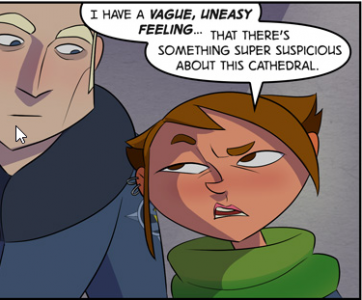Exploiting the Player-Character Knowledge Gap for Fun and Profit
One of the most interesting interactions in RPGs is the Player-Character Knowledge Gap – your character doesn’t know the same things you know, and vice versa.
For example, Lily’s character Raffaela is a devout, erm, whatever this religion is. Her religious belief is one of the only things in her life she’s not cynical about, so we can assume that Raffaela knows a lot about this religion, even though Nadav and Lily haven’t actually invented most of it yet; so Lily’s character can be said to know about this more than Lily herself does.
At the same time, Lily knows how to operate an Android phone, something her character can never even hope to know, since they don’t have Android Phones in the world of Crystal Heart, and they are all the lesser for it.
So the gap is real, and in this week’s page we focus on a specific interaction that occasionally occurs on its edges: Lily is aware there’s a reason to roll Notice, and even though she failed the check, she’s still suspicious. This suspicion bridges the gap, so while Raffaela didn’t notice anything, she still becomes suspicious as a result of her player becoming so.
This is sometimes called “mixing player-knowledge and character-knowledge”, which is considered a big no-no in some parties, but I would like to argue against this conception. I agree that it’s generally preferable to keep the two separate, but I would claim that not only is that impossible to completely achieve, there are even parties in which you shouldn’t try too hard, and even more, there are ways for a GM to use this gap for the betterment of the story.
The simple fact is, there’s no way to completely avoid this gap – you can’t un-know a thing, and knowing something always influences your actions (and the way you play your character). Some players are better at separating themselves from the characters they portray, but some are really bad at it; this should not be a contest, nor a requirement for a good game. The gap is a feature, not a bug, and there are various ways to use it for good, fun effects.

The mouse pointer represents chin finger-scratching.
Let’s look at Lily’s Notice roll as an example.
It begins with Nadav, the GM. He wants to set a certain mood for the scene. Bogovia is dark and gloomy, and he wants the players to feel a bit worried, at unease, perhaps paranoid. There are several ways to do this, but we’ll focus on the way he uses the rules and the gap.
He knows his wife, Lily, very well. He knows that the minute something draws her attention, she’s not going to let it go. Therefore, he decides to push her in a direction that will help in building the tense atmosphere – he wants to make her aware of the possibility she’s missing something. That’ll keep her on her toes, and she’ll bring the other players along for the ride. It doesn’t matter what she’s missing, or if there’s even something to miss; but more on that in a later post.
Without provocation from the players – that is, not as a response to their actions – he asks Lily to roll Notice, mentioning this roll only happens because Raffaela is a native Bogovian. That means there’s some hidden secret in the cathedral! Something juicy that only Lily can know about! She gets all primed up.
Lily rolls. If she makes the roll, Nadav will tell her she notices a specific thing, focusing on how it’s off in some way. If she fails, he doesn’t give any specific information, but still reassures the tense atmosphere by saying there’s a vague, uneasy, feeling about this place – and this little addition is all thanks to his understanding of the Player-Character Knowledge Gap.
This is a lot better than just saying “you didn’t notice anything, let’s continue”. First, because it allows Nadav to gain what he wanted – making Lily suspicious. Secondly, because it allows the party to rationalise why Raffaella is now suspicious as well. Nadav’s words describe what the character is feeling – it’s easy to imagine how Raffaella gets a strange shiver all of a sudden, a feeling that something’s not right. The gap can break suspension of disbelief sometimes, and so Nadav is trying to bridge it with an in-world description. He knows the roll had an emotional effect on his player, now he must smooth the transition of this effect into the game world. This is doubly important since Lily isn’t the sort of player who’s good at separating herself from her character – when she’s in, she’s all in.
(Also, compare that to Nadav just saying “You all feel an uneasy feeling as you enter the place”, without any rolls. That’s fine, and it’s a way to completely avoid any need to managing the gap – but thanks to the roll, Lily is engaged in the story and motivated to explore further. Roll, don’t tell.)
Oh, and also, Hopeless said an interesting thing in the comments to the page: Why can’t she just ask Mac to roll Notice now? I gave an answer there.



